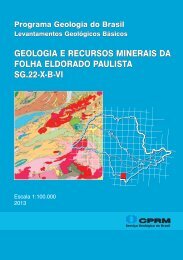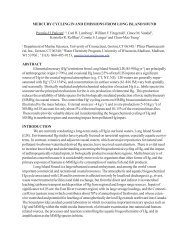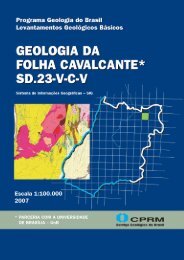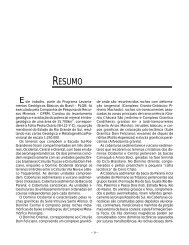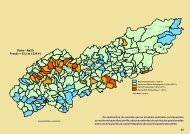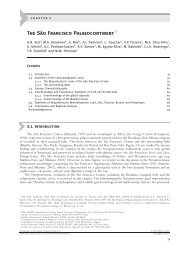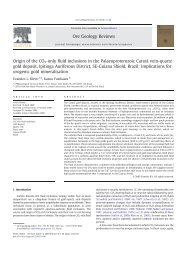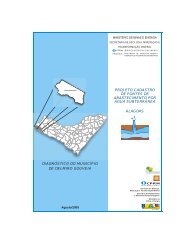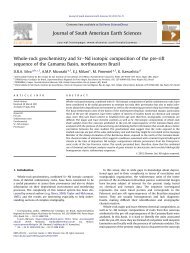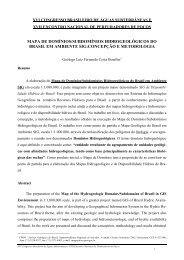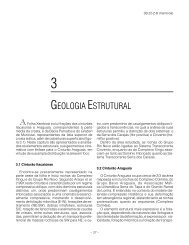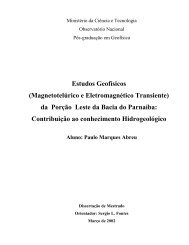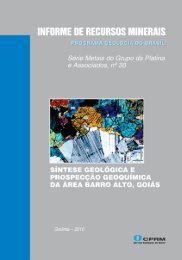Geologia e Recursos Minerais da Folha Aripuanã - CPRM
Geologia e Recursos Minerais da Folha Aripuanã - CPRM
Geologia e Recursos Minerais da Folha Aripuanã - CPRM
Create successful ePaper yourself
Turn your PDF publications into a flip-book with our unique Google optimized e-Paper software.
<strong>Geologia</strong> e <strong>Recursos</strong> <strong>Minerais</strong> <strong>da</strong> <strong>Folha</strong> <strong>Aripuanã</strong><br />
10<br />
ABSTRACT<br />
This report contains the results of a systematic geological mapping, geochemical regional<br />
survey results, in a 1:250.000 scale, and the evaluation of the metalogenetic potential of the <strong>Folha</strong><br />
<strong>Aripuanã</strong> (SC.21-Y-A), located in northwest portion of State of the Mato Grosso, with an area of<br />
18.000 km². The mapping project is part of the Northwest Project of Mato Grosso performed by<br />
agreement between the Geological Survey of Brazil (<strong>CPRM</strong>) and SICME, and part of the Geology<br />
Program of Brazil.<br />
The study was developed using interpretation techniques of geological maps and SRTM and<br />
ETM+ images. The remote sensing products and aerogeophysical <strong>da</strong>ta were processed by means<br />
of ENVI and integrated in a Geographic Information System (GIS). The fieldworks were performed<br />
by geological profiles along roads and paths with outcrop description. Petrography and lithochemical<br />
analyses, geochronologic <strong>da</strong>ting (U-Pb and Sm-Nd methods), and systematic sampling of stream<br />
sediments and pan concentrated were also carried.<br />
The multidisciplinary integration of the obtained <strong>da</strong>ta allowed to establish a new stratigraphic<br />
ordering for the area, which is constituted by Proterozoic plutono-volcanic terrains and sedimentary<br />
basins of the southwestern portion of the Amazon Craton, being part of the Rondônia-Juruena<br />
Province (1.810-1.520 Ma) subdivided into the Roosevelt-<strong>Aripuanã</strong> (1.790 Ma) and the Jamari (1.760-<br />
1.535 Ma) domains.<br />
The Roosevelt-<strong>Aripuanã</strong> domain is a plutono-volcanic segment composed of the following<br />
lithodemic units: (i) Vitória Intrusive Suite (1,77 Ga) – tonalites, granodiorites and quartzmonzodiorites;<br />
(ii) São Pedro Granite (1,78 Ga) - granodiorites, biotite-amphibole granodiorites<br />
and quartz-diorites; (iii) Zé do Torno Granite (1.77 Ga) – deformed monzogranites and syenogranites;<br />
(iv) Roosevelt Group (1.74 Ga) subdivided into two sequences: a) metavolcanic unit – riolitos,<br />
<strong>da</strong>cites and pyroclastic rocks, and b) metasedimentary unit - chert, iron formation, ferruginous<br />
quartzites and metapelites; (v) Nova Canaã Suite (1,74 Ga) - monzogranites and quartz-syenites;<br />
(vi) Serra do Cafundó Basic Intrusives – dikes and sills of microgabbro, diabase and diorite. Rocks<br />
of the Vitória Suite have petrographic and chemical characteristics similar to those of magmatic<br />
arcs, here called as Roosevelt (1,79-1,65 Ga).<br />
This period was succeeded by a late orogenic to post-collisional event represented by high-<br />
K calc-alkaline magmatism (Zé do Torto and São Pedro granites, Nova Canaã Intrusive Suite and<br />
the Roosevelt Group).<br />
The Jamari domain formed under an anorogenic regime and is represented by (i) the <strong>Aripuanã</strong><br />
Granite (1,54 Ga) – alkali granites and syenogranites; (ii) Rio Vermelho Granite – porphyritic and<br />
rapakivi syenogranites; (iii) Fontanillas Granite - biotite syenogranites and porphiritc and rapakivi<br />
biotite syenogranites and (iv) the Canamã Alkaline rocks - syenites, microsyienites, quartz-syenites,<br />
and biotite trachyte. This plutonic set integrates an AMCG association, typical of anorogenic<br />
environment, with all its representatives mapped and defined in the <strong>Folha</strong> Juína.<br />
The Mesoproterozoic is represented by rocks of the Dar<strong>da</strong>nelos Basin, which consists of the<br />
metasedimentary rocks of the Dar<strong>da</strong>nelos Formations and mafic dikes and sills of the Arinos<br />
Formation.<br />
Two tectono-structural domains occur in the area, one ductile (Dn+1) and another brittle to<br />
brittle-ductile (Dn+2), developed in compressional and transtensional regimes. The ductile domain<br />
is marked by E-W/subvertical sinistral strike-slip shear zones, conjugated with NW-SE oblique shear<br />
zones, with the maximum NE-SW compressive vector.<br />
The brittle to brittle-ductile domain is characterized by restrict, centimetric to metric shear<br />
zones derived by fracture and/or fault nucleation preferably oriented NE-SW, which crosscut and<br />
displace the ductile E-W to NW-SE shear-zones formed during the Dn+1 event.<br />
Regional geochemical survey results integrated with aerogeophysical anomaly <strong>da</strong>ta recognized<br />
the already known mineralized areas, as the <strong>Aripuanã</strong> polimetalic deposit (Zn, Pb, Ag, Cu, Au) and<br />
auriferous occurrences (Garimpo Mastigado I and II). They also lead to the identification of new<br />
targets, the main being the Fe, Au, and Ag anomalies associated with metasedimentary rocks of<br />
the Roosevelt Group, specially the iron formations; Ag and Au anomalies associated to the <strong>Aripuanã</strong><br />
Granite and Canamã alkaline rocks; Sn, Be, Au, Ag and REE anomalies related to hydrothermal<br />
geophysical signatures in shear zones and the Cr, Ni, Co, Zn, Ag and Au anomalies associated to<br />
the gabbros and basalts of the Arinos Formation.



